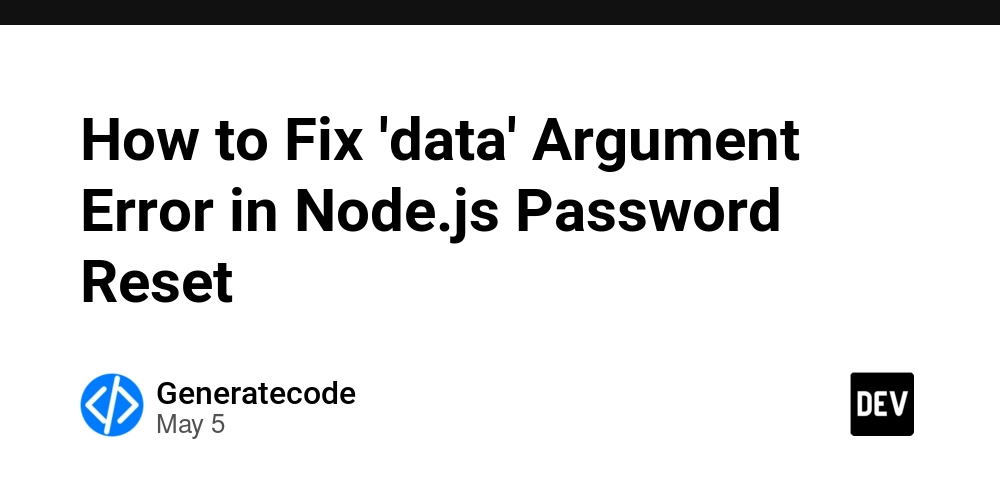How to Fix 'data' Argument Error in Node.js Password Reset
Introduction When developing a password reset feature in a Node.js and Express application, it's common to encounter various issues. One problem that developers often face is the 'data' argument must be of type string or an instance of Buffer error when using the crypto module to hash passwords. In this article, we will dive into the causes of this error and provide a clear, step-by-step solution to resolve it while optimizing your password reset functionality. Understanding the Error The error message you are encountering indicates that the update function from the crypto module is receiving an undefined value when it tries to hash the password. This typically occurs if the password is missing or if the body of the request does not include the password key. In the context of a password reset, it's crucial that users provide a valid new password for the operation to succeed. Reasons the Error Might Occur There are several reasons why you may receive this error: Empty Request Body: The POST request to your /reset-password endpoint might not be sending the password properly. Incorrect Key Name: The key in your request payload may not match what you are trying to destructure in your function – specifically, password. Middleware Issues: The middleware you are using to parse the JSON body may not be properly configured. Debugging Steps Before we jump into the solution, let’s confirm a few things: Ensure that your client-side code is indeed sending the required fields in the body. Check your network request in the browser’s developer tools and confirm that the payload includes both token and password. Step-by-Step Solution 1. Verify the Client-Side Code Ensure that your client sends a JSON object containing the token and the password: const resetPassword = async (token, password) => { try { const response = await fetch('/reset-password', { method: 'POST', headers: { 'Content-Type': 'application/json', }, body: JSON.stringify({ token, password }), }); const data = await response.json(); console.log(data.message); } catch (error) { console.error('Error in password reset:', error); } }; 2. Update the Password Reset Function Ensure the destructuring in the resetPassword function accurately reflects your request structure: export const resetPassword = async (req, res) => { try { const { token, password } = req.body; // Check if password is provided if (!password) { return res.status(400).json({ message: 'Password is required' }); } // Find user by reset token const user = await User.findOne({ where: { reset_token: token, reset_token_expires: { [Op.gt]: new Date() }, }, }); if (!user) { return res.status(400).json({ message: 'Invalid or expired reset token' }); } // Hashing the new password const hashedPassword = crypto .createHash('sha256') .update(password) .digest('hex'); // Update user password and clear the reset token await user.update({ password: hashedPassword, reset_token: null, reset_token_expires: null, }); res.status(200).json({ message: 'Password reset successful' }); } catch (error) { logger.error('Error in resetPassword:', error); res.status(500).json({ message: 'Error resetting password' }); } }; 3. Ensure Middleware is Properly Configured Make sure you're using the correct middleware to parse JSON body in your Express app: import express from 'express'; const app = express(); app.use(express.json()); // Adds JSON body parsing middleware 4. Check Node.js and Package Versions Ensure that your Node.js, Express, and Sequelize versions are compatible and up to date: Node.js: 18.x Express: 4.x Sequelize: 6.x Frequently Asked Questions (FAQ) What should the request payload look like? The request payload should be structured as follows: { "token": "your-reset-token", "password": "your-new-password" } How can I generate a reset token in Node.js? A common approach is to create a token using crypto's random bytes method. You can store this token in the database to validate it later. const token = crypto.randomBytes(32).toString('hex'); What database changes are required? Ensure your User model has the required columns for reset_token and reset_token_expires to facilitate the password reset functionality. Conclusion In this article, we tackled the common error in a Node.js password reset feature where the crypto update method is passed an undefined value. We examined the causes and provided detailed solutions to ensure your password reset functionality operates smoothly. By ensuring proper configuration and clear request handling, you can enhance your application's user experience and security.

Introduction
When developing a password reset feature in a Node.js and Express application, it's common to encounter various issues. One problem that developers often face is the 'data' argument must be of type string or an instance of Buffer error when using the crypto module to hash passwords. In this article, we will dive into the causes of this error and provide a clear, step-by-step solution to resolve it while optimizing your password reset functionality.
Understanding the Error
The error message you are encountering indicates that the update function from the crypto module is receiving an undefined value when it tries to hash the password. This typically occurs if the password is missing or if the body of the request does not include the password key. In the context of a password reset, it's crucial that users provide a valid new password for the operation to succeed.
Reasons the Error Might Occur
There are several reasons why you may receive this error:
-
Empty Request Body: The POST request to your
/reset-passwordendpoint might not be sending the password properly. -
Incorrect Key Name: The key in your request payload may not match what you are trying to destructure in your function – specifically,
password. - Middleware Issues: The middleware you are using to parse the JSON body may not be properly configured.
Debugging Steps
Before we jump into the solution, let’s confirm a few things:
- Ensure that your client-side code is indeed sending the required fields in the body.
- Check your network request in the browser’s developer tools and confirm that the payload includes both
tokenandpassword.
Step-by-Step Solution
1. Verify the Client-Side Code
Ensure that your client sends a JSON object containing the token and the password:
const resetPassword = async (token, password) => {
try {
const response = await fetch('/reset-password', {
method: 'POST',
headers: {
'Content-Type': 'application/json',
},
body: JSON.stringify({ token, password }),
});
const data = await response.json();
console.log(data.message);
} catch (error) {
console.error('Error in password reset:', error);
}
};
2. Update the Password Reset Function
Ensure the destructuring in the resetPassword function accurately reflects your request structure:
export const resetPassword = async (req, res) => {
try {
const { token, password } = req.body;
// Check if password is provided
if (!password) {
return res.status(400).json({ message: 'Password is required' });
}
// Find user by reset token
const user = await User.findOne({
where: {
reset_token: token,
reset_token_expires: { [Op.gt]: new Date() },
},
});
if (!user) {
return res.status(400).json({ message: 'Invalid or expired reset token' });
}
// Hashing the new password
const hashedPassword = crypto
.createHash('sha256')
.update(password)
.digest('hex');
// Update user password and clear the reset token
await user.update({
password: hashedPassword,
reset_token: null,
reset_token_expires: null,
});
res.status(200).json({ message: 'Password reset successful' });
} catch (error) {
logger.error('Error in resetPassword:', error);
res.status(500).json({ message: 'Error resetting password' });
}
};
3. Ensure Middleware is Properly Configured
Make sure you're using the correct middleware to parse JSON body in your Express app:
import express from 'express';
const app = express();
app.use(express.json()); // Adds JSON body parsing middleware
4. Check Node.js and Package Versions
Ensure that your Node.js, Express, and Sequelize versions are compatible and up to date:
- Node.js: 18.x
- Express: 4.x
- Sequelize: 6.x
Frequently Asked Questions (FAQ)
What should the request payload look like?
The request payload should be structured as follows:
{
"token": "your-reset-token",
"password": "your-new-password"
}
How can I generate a reset token in Node.js?
A common approach is to create a token using crypto's random bytes method. You can store this token in the database to validate it later.
const token = crypto.randomBytes(32).toString('hex');
What database changes are required?
Ensure your User model has the required columns for reset_token and reset_token_expires to facilitate the password reset functionality.
Conclusion
In this article, we tackled the common error in a Node.js password reset feature where the crypto update method is passed an undefined value. We examined the causes and provided detailed solutions to ensure your password reset functionality operates smoothly. By ensuring proper configuration and clear request handling, you can enhance your application's user experience and security.





































































































































































![[The AI Show Episode 145]: OpenAI Releases o3 and o4-mini, AI Is Causing “Quiet Layoffs,” Executive Order on Youth AI Education & GPT-4o’s Controversial Update](https://www.marketingaiinstitute.com/hubfs/ep%20145%20cover.png)






























































































































![[DEALS] Microsoft 365: 1-Year Subscription (Family/Up to 6 Users) (23% off) & Other Deals Up To 98% Off – Offers End Soon!](https://www.javacodegeeks.com/wp-content/uploads/2012/12/jcg-logo.jpg)









































































































.jpg?#)
.jpg?#)

































_Inge_Johnsson-Alamy.jpg?width=1280&auto=webp&quality=80&disable=upscale#)













































































































![New Powerbeats Pro 2 Wireless Earbuds On Sale for $199.95 [Lowest Price Ever]](https://www.iclarified.com/images/news/97217/97217/97217-640.jpg)
![Alleged iPhone 17-19 Roadmap Leaked: Foldables and Spring Launches Ahead [Kuo]](https://www.iclarified.com/images/news/97214/97214/97214-640.jpg)

![New Apple iPad mini 7 On Sale for $399! [Lowest Price Ever]](https://www.iclarified.com/images/news/96096/96096/96096-640.jpg)



































































































